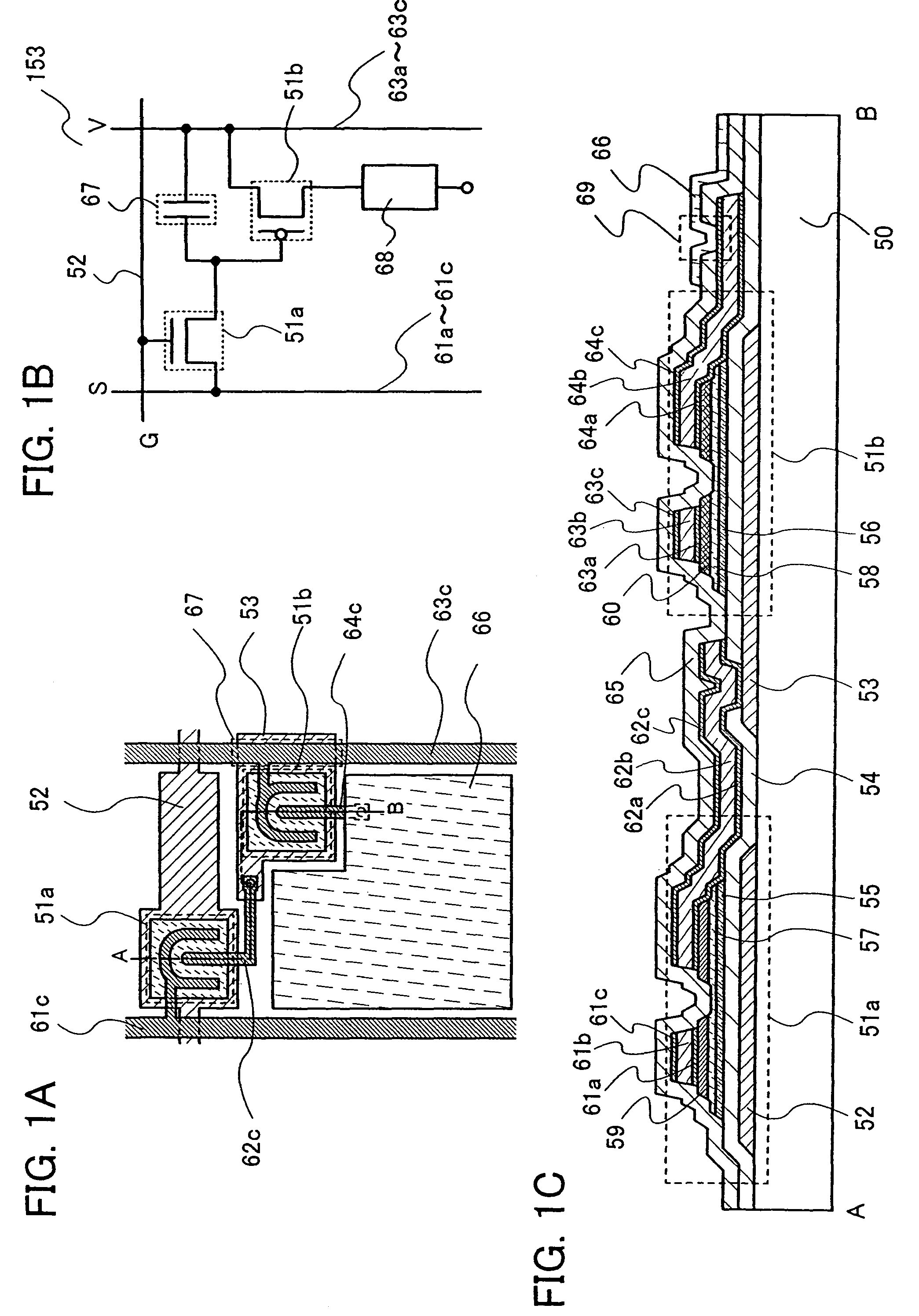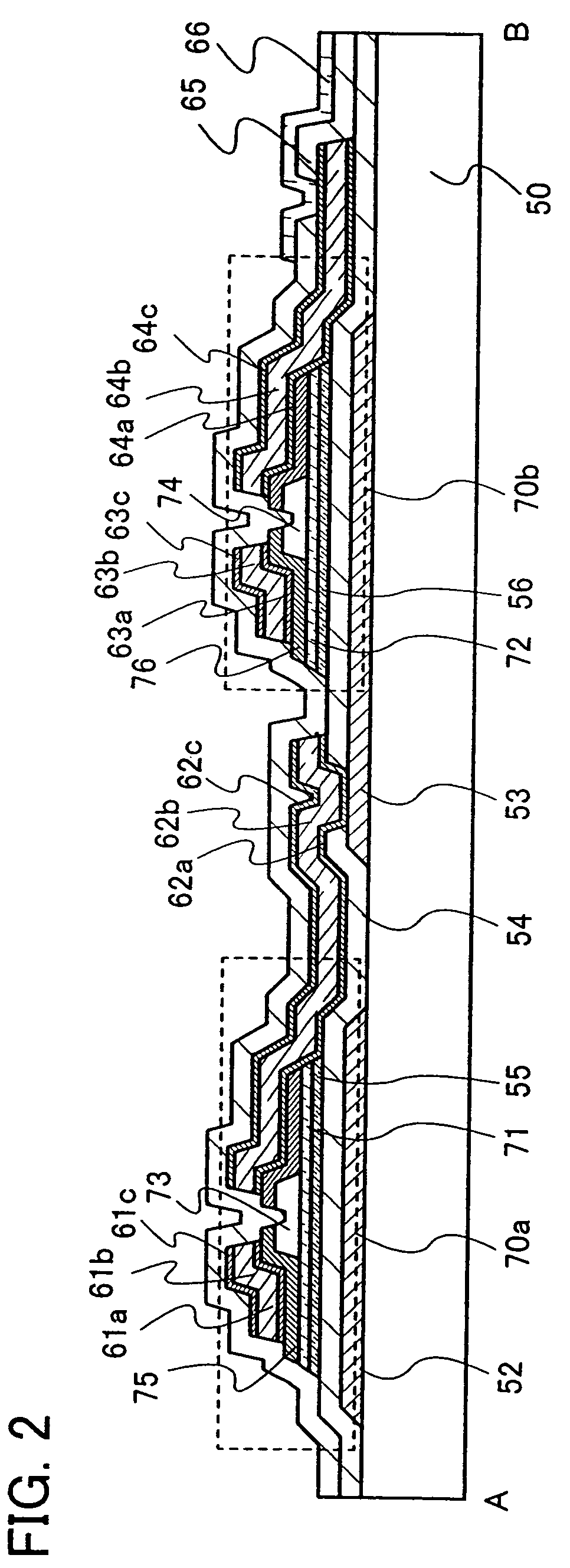Display device
a display device and display technology, applied in the field of display devices, to achieve the effect of excellent electric characteristics, high reliability and high productivity
- Summary
- Abstract
- Description
- Claims
- Application Information
AI Technical Summary
Benefits of technology
Problems solved by technology
Method used
Image
Examples
embodiment mode 1
[0046]The structure of a pixel included in a display device of this embodiment mode is described. FIG. 1A illustrates one mode of the top plan view of a pixel. FIG. 1B illustrates one mode of the equivalent circuit diagram of a pixel. FIG. 1C illustrates one mode of the cross-sectional structure of a pixel along A-B in FIG. 1A.
[0047]In FIGS. 1A to 1C, a first thin film transistor 51a and a second thin film transistor 51b correspond to a switching thin film transistor for controlling input of a signal to a pixel electrode or a driving thin film transistor for controlling current or voltage application to a light-emitting element 68.
[0048]A gate electrode of the first thin film transistor 51a is connected to a scan line 52, one of a source or a drain of the first thin film transistor 51a is connected to wirings 61a to 61c which function as signal lines, and the other of the source or the drain is connected to a gate electrode 53 of the second thin film transistor 51b. One of a source ...
embodiment mode 2
[0082]In this embodiment mode, a plasma CVD apparatus and the method for depositing the gate insulating film, the microcrystalline semiconductor film, the buffer layer, the n-type semiconductor film, the p-type semiconductor film, the protective insulating film, and the like, which are described in Embodiment Mode 1, are described with reference to FIG. 3, FIG. 4, FIG. 5, and FIG. 24.
[0083]FIG. 3 illustrates one structure example of the plasma CVD apparatus to which high-frequency power is applied. A reaction chamber 400 is formed with a material having rigidity, such as aluminum or stainless steel, and provided with a system for performing vacuum evacuation inside the reaction chamber 400. The reaction chamber 400 is provided with a first electrode 401 and a second electrode 402.
[0084]The structure of the plasma CVD apparatus is such that the first electrode 401 is connected to a high-frequency power supply means 403, a ground potential is applied to the second electrode 402, and a...
embodiment mode 3
[0117]Next, light-emitting devices which are one mode of display devices are described with reference to FIGS. 1A to 1C, FIGS. 6A to 6C, and FIG. 7. As such light-emitting devices, light-emitting elements utilizing electroluminescence are used for description, here. Light emitting elements utilizing electroluminescence are classified according to whether a light-emitting material is an organic compound or an inorganic compound. In general, the former is referred to as an organic EL element and the latter is referred to as an inorganic EL element.
[0118]In the case of an organic EL element, by applying a voltage to the light-emitting element, electrons and holes are injected from a pair of electrodes into a layer containing an organic compound with a light-emitting property to cause a current flow. Then, recombination of these carriers (the electrons and holes) results in an excited state of the organic compound with a light-emitting property, and light is emitted when the excited sta...
PUM
 Login to View More
Login to View More Abstract
Description
Claims
Application Information
 Login to View More
Login to View More - R&D
- Intellectual Property
- Life Sciences
- Materials
- Tech Scout
- Unparalleled Data Quality
- Higher Quality Content
- 60% Fewer Hallucinations
Browse by: Latest US Patents, China's latest patents, Technical Efficacy Thesaurus, Application Domain, Technology Topic, Popular Technical Reports.
© 2025 PatSnap. All rights reserved.Legal|Privacy policy|Modern Slavery Act Transparency Statement|Sitemap|About US| Contact US: help@patsnap.com



